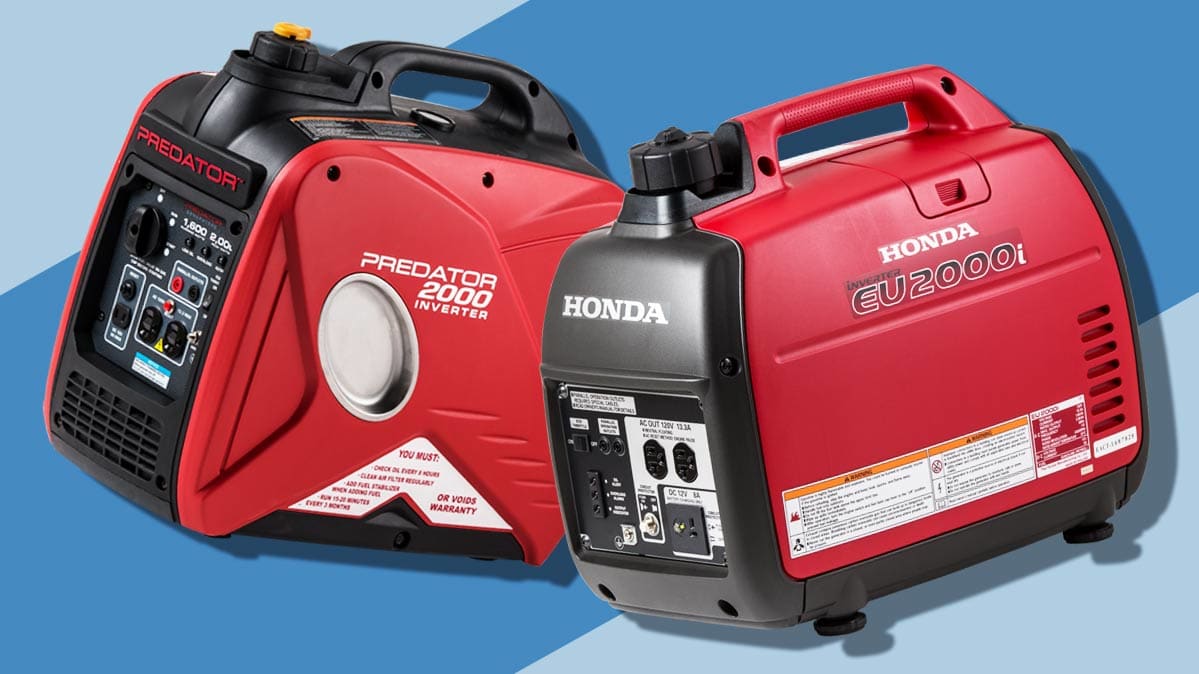Can a Harbor Freight Generator Really Beat a Honda?
In CR's face-off, one of these popular recreational inverter generators costs half as much as the other

Harbor Freight, a giant retailer of low-priced tools and power equipment, has been around since the 1970s. If you live near a Harbor Freight store, chances are you've received a circular comparing the Predator 62523 recreational inverter generator to the Honda EU2000iT1A1.
Given the big price difference—the Predator sells for $500 and the Honda for $1,000—are they comparable? Yes, according to Consumer Reports' testing.
More on Generators
"The inverter generators we've tested from Predator are really refined pieces of equipment, easily meeting power demands and humming along quietly," says Dave Trezza, who oversees CR's generator testing.
In fact, both the Predator 62353 and another model from Harbor Freight, the Predator 3500, rank well enough in CR's ratings for us to recommend.
Inverter generators aren't really the tools you'd rely on to keep lights on after a storm—they're small models better suited for tailgates and campsites, though in a pinch they can keep your fridge and lights on. They max out at 2,000 watts.
Harbor Freight's circular makes a compelling, point-by-point case for why you should choose the Predator over the Honda, starting with its ultralow price. But we wanted to get to the bottom of what's most important: how each model performs under strain. We tested both, along with dozens of other models, and we provide full scores in our generator ratings charts, available to CR members.
If you're unsure about which type of generator you need, start with our generator buying guide. For now, read on for our point-by-point comparison of these two recreational models, both of which occupy top spots in our ratings.
We're Not Loyal to Brands.
We're Loyal to You.
How We Test Generators
For each generator, we connect a combination of lights, space heaters, and fans—appliances that draw a constant load—then tack on a power-hungry well pump and program it to cycle on and off at set intervals.
Some generators can meet demands immediately, only to fail and trip their own circuit breaker later. So we run this test for an hour, metering wattage, voltage, and amperage. If a model passes, we repeat the test twice more, adding 1,000 watts to the load each time. That's just for the power delivery score, one of four that make up a model's Overall Score.
The Face-Off
Specs
Both the Predator 62523 and the Honda EU2000iT1A1 are rated for 1,600 watts, or a 2,000-watt surge load. Both have two power outlets and automatically shut off if fuel or oil drops too low during use; each weighs around 50 pounds. The Honda has a slightly smaller 0.95-gallon tank; the tank on the predator is a full gallon. While that difference may seem insignificant, in our tests, the larger tank did help the Predator run slightly longer without adding fuel, 4 to 10 hours per tank, compared with 4 to 8 for the Honda. Each model has a fuel gauge and an indicator light to tell you if the unit has shut off because of low oil. Both are parallel capable, meaning you can buy more than one of the same model, connect them with a power cord, and run a group of electronics that would exceed the output of a single generator.
Performance
Each generator functions impressively, but the Honda has a slight edge. In our most important test—power delivery—the Honda earns a rating of Excellent, while the Predator rates a Very Good. That difference is subtle and mostly reflects how well each model might handle a spike in energy demand while in use. Both get solid marks for power quality—important for running sensitive electronics, such as speakers. Both are very, very quiet (we measure sound levels at a distance of 23 feet), and CR found both models to be simple and easy to use.
Warranty and Reliability
Honda guarantees its generator for three years, and the warranty covers all parts. Harbor Freight guarantees its generator for only 90 days, but it covers emissions components for two years, provided you've followed the proper maintenance schedule. Consumer Reports members who own Honda portable generators give these models some of the highest marks for satisfaction. Harbor Freight owners are pretty happy, too. We get into specifics on satisfaction and starting problems in "Generators You Can Count on During a Power Outage."
CR members can check out detailed test results and Overall Score here.
The Winner
On points and performance, the Honda wins by a narrow margin, largely because of its ability to deliver power constantly and reliably—it works without tripping its own internal circuit breaker as we added to its load, right up to the generator's claimed capacity. But the Predator is the clear winner on price. Were the warranties identical, we'd certainly crown the Predator as the better buy. But with a 90-day warranty, there's no guarantee it will survive even a single season.
Our advice: If you're going to use your recreational generator for camping or tailgating, consider buying the Predator. But if you also want to be able to rely on the generator as a source of backup power for your home (to keep the refrigerator and lights on during an outage), the Honda makes more sense and is a worthy investment.
No comments:
Post a Comment